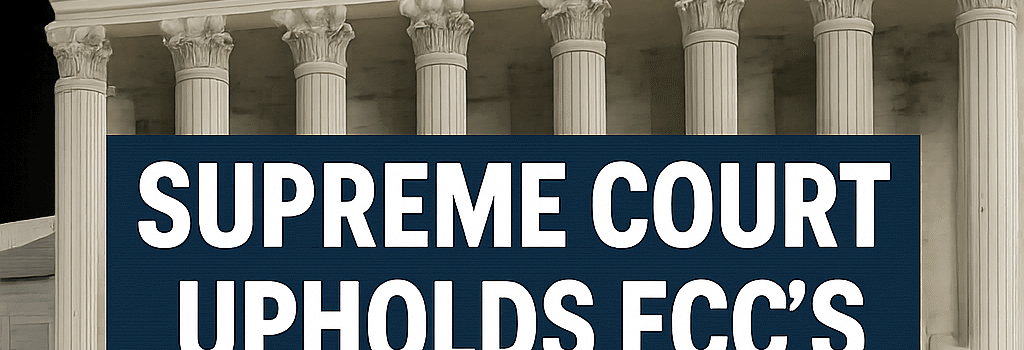Supreme Court Upholds FCC’s $8B Universal Service Fund

Background: The Universal Service Fund’s Role in Bridging the Digital Divide
The Universal Service Fund (USF) remains one of the cornerstone programs of U.S. telecommunications policy, channeling approximately $8 billion annually to expand high-speed Internet and voice services across urban, rural, and low-income communities. Created under Section 254 of the Communications Act, the USF comprises several subprograms:
- Lifeline: Provides monthly discounts up to $9.25 for qualifying low-income consumers to purchase broadband and phone service.
- E-Rate: Allocates ~ $3.9 billion each year to schools and libraries for Wi-Fi networks, fiber connections, and edge-security appliances.
- Rural Health Care Program: Subsidizes terminals and broadband connections for healthcare clinics, enabling telemedicine and secure VPNs.
- High-Cost/Connect America Fund: Disburses grants and loans to incumbent carriers and competitive providers for fiber-to-the-premises (FTTP) and fixed wireless across sparsely populated areas.
Supreme Court Decision and Nondelegation Doctrine
In a 6–3 ruling delivered on June 27, 2025, Justice Elena Kagan writing for the majority reversed the Fifth Circuit’s en banc decision that deemed USF contributions an unconstitutional tax. The Court reaffirmed that Congress may delegate revenue-raising authority without setting a precise numeric ceiling, so long as it provides an “intelligible principle.” The majority noted that treating fees and taxes identically under the nondelegation doctrine avoids destabilizing dozens of longstanding federal programs.
“Whether a charge is labeled a tax or a fee is irrelevant to the nondelegation inquiry,” the opinion states, adding that imposing a mandatory numeric cap would produce “absurd results” by invalidating countless federal schemes from highway tolls to airline passenger facility charges.
Chief Justice Roberts and Justices Sotomayor, Kavanaugh, Barrett, and Jackson joined the opinion. Justice Gorsuch dissented, arguing that Section 254 impermissibly handed Congress’s taxing power to the FCC and, by extension, to a private administrator.
Technical Mechanics of USF Administration
The Federal Communications Commission (FCC) appoints the Universal Service Administrative Company (USAC) board, approves its budget, and oversees its quarterly projections. The process works as follows:
- USAC projects total fund disbursements for the next quarter, factoring in program commitments and administrative costs.
- USAC collects revenue estimates from over 1,000 telecommunications carriers based on their interstate and international retail revenues.
- It submits a proposed contribution factor (a percentage rate) to the FCC, which reviews and publishes it to take effect.
- Carriers then impose the contribution factor onto end-users via a line item on phone and broadband bills; funds flow back to USAC for distribution.
From a technical standpoint, USAC employs secure data pipelines and automated reconciliation systems that validate carrier reports using RESTful APIs and encrypted SFTP transfers. Recent upgrades have introduced AWS-hosted analytics dashboards and machine-learning models to detect anomalies and prevent fraud.
Implications for Network Operators and Consumers
By preserving the USF, the ruling ensures continuity of funding for fiber-optic deployments compliant with ITU-T G.652 standards, DOCSIS 3.1 cable upgrades, and next-generation 5G fixed wireless trials in remote areas. Experts note:
- Telecom Economist Dr. Sarah Patel: “Removing USF would have triggered a 15–20% hike in consumer bills in small markets and slowed fiber rollouts by at least two years.”
- Broadband Policy Analyst Mark Rivera: “The decision underpins investor confidence in Rural Digital Opportunity Fund (RDOF) auctions and private fixed wireless partnerships backed by Citizens Broadband Radio Service (CBRS).”
Consumer advocates also praise the ruling for protecting Lifeline eligibility, which now serves over 8 million subscribers and relies on automated eligibility verification through APIs with the Department of Health and Human Services.
Latest Developments: FCC Digital Equity and Funding Reforms
Concurrent with the Court’s decision, the FCC advanced a Digital Equity Order aimed at allocating $2.75 billion from the Infrastructure Investment and Jobs Act to close the homework gap. The order mandates:
- State digital equity planning grants combining GIS-based mapping and community-driven needs assessments.
- Dedicated funds for anchor institutions to provide managed Wi-Fi networks and device loans using Population Broadband Data.
- Enhanced cybersecurity requirements, including NIST SP 800-171 compliance for public-private partnerships.
FCC Chairman Brendan Carr signaled further reforms to streamline USF audits and incorporate blockchain-based voucher tracking to reduce administrative overhead by up to 30%.
Future Outlook and Policy Trends
With the Supreme Court’s green light, expect the FCC to:
- Refine contribution formulas to reflect shifting VoIP and bundled broadband packages, potentially adjusting the FCC’s Cost of Service model.
- Expand pilot programs leveraging TV White Spaces (IEEE 802.11af) and millimeter-wave spectrum in underconnected regions.
- Coordinate with NTIA and USDA on joint grants using the USDA’s ReConnect framework to accelerate FTTP to farms and co-ops.
Longer term, experts anticipate new debates over private vs. public administration of infrastructure funds, the role of AI in enrollment verification, and whether nondelegation challenges might extend to other agencies under the Major Questions Doctrine.
Conclusion
The Supreme Court’s decision preserves a vital lifeline for millions of Americans and thousands of institutions—ensuring that federal broadband subsidies can continue to evolve technically and administratively without constitutional impediment.
— Jon Brodkin, Senior IT Reporter